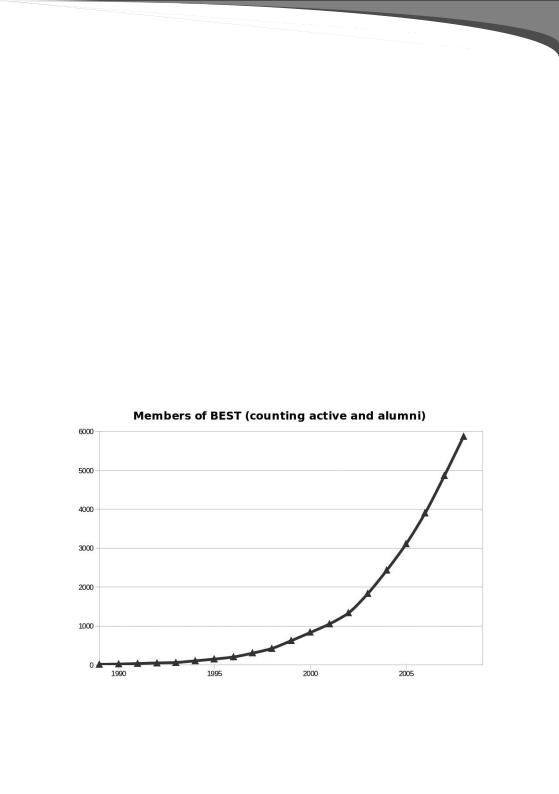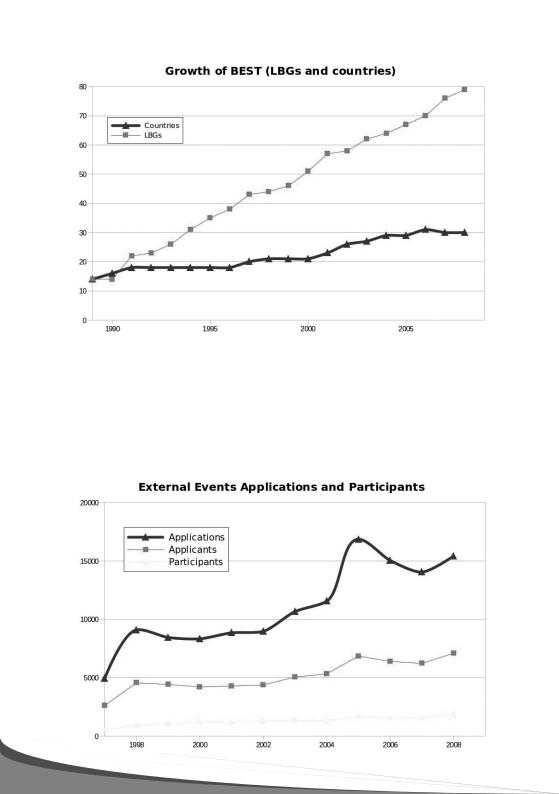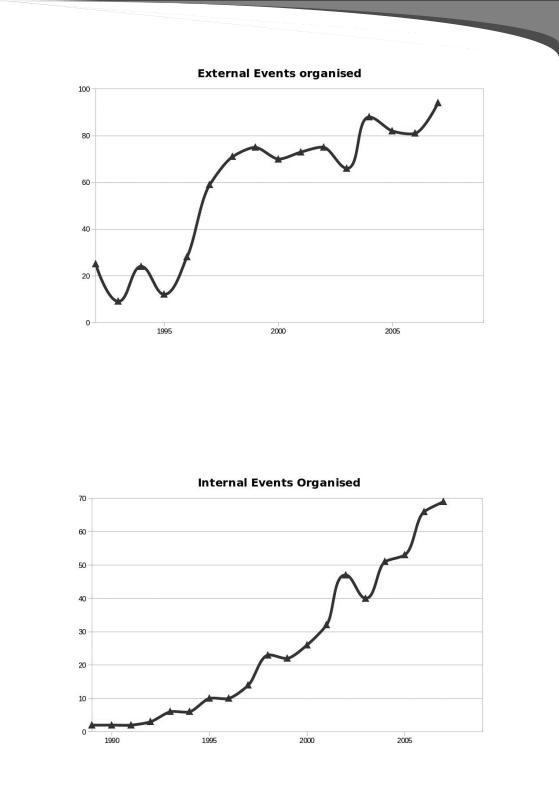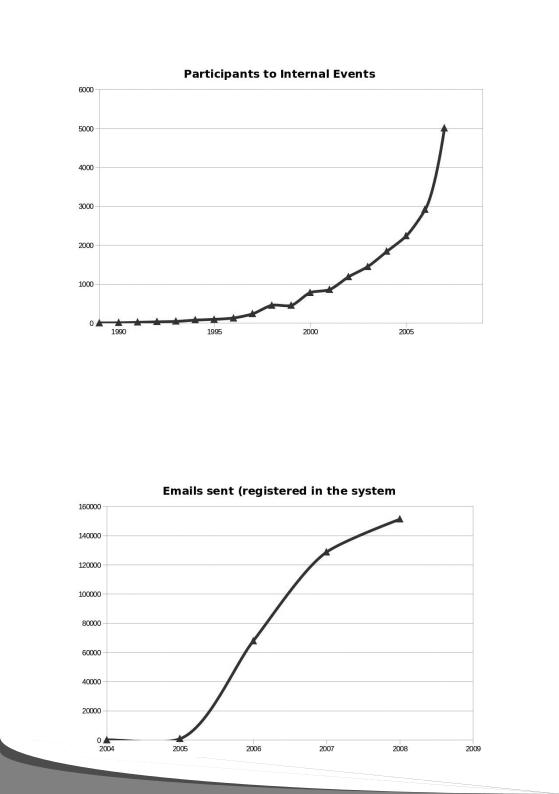
History Book of BEST
.pdf
21
The delegates liked the idea and by the next meeting, PM 1995 (first President’s Meeting) the Strategy Committee with another subgroup – the Future Subgroup – should prepare a proposal of the 3YP.
Concerning Growth, at GA Patras a Forum was organised where lots of ideas and opinions popped up about limited or unlimited growth, what kind of Universities to accept and what to follow at an applying university.
Concerning communication, 1995 was a big leap for the organisation. Solutions like FTP-file transfer protocol, www technology and IRC –a real time platform for instant messages were presented to overcome the communication barriers.
The work of the Continuity committee was in progress. For GA they prepared four topics for the delegates: the archive and general secretariat, alumni, committee’s work and a handbook with guidelines on how to start and run an LBG.
One of the problems was the archive of BEST. The General Secretariat’s main task was to gather the documents and to secure them in one place. Besides that, other tasks of the secretariat were:
•Daily email check.
•They had to answer the questions ASAP but one week answering time was given.
•They had to inform every LBG about their holidays a month in advance and even then check their mail and answer at least once a month.
•They had to be able to fax answers.
•Should be reliable and happy people.
•Had to attend GAs, PMs and had to attend WSs if possible.
•Had to find and train their own successors
In the action plan that the general secretariat had to prepare for PM in fall, one subject was the creation of the Where Ideas Never Die mailing list (WIND). At this mailing list, people from BEST could send ideas of any type that concluded in the improvement of the organisation.
Towards the committees, the Continuity group presented a set of recommendations, one of the most important being the creation of the coordinator of the group that had to lead the committee and its projects.
For the LBG handbook, a proposal was that the LBG in charge of the updating the handbook should do it for 5 years to preserve continuity and unity.
For the PM 1995 in Trondheim, the continuity committee prepared the 3YP that included not only the work of the Board for three years but the work of the whole organisation. The plan was given for feedback to the LBGs for improvement and the final one consisted of the aims,

Chapter 1:
BEST: Beginning, Struggles, Milestones, Development
mission and goals of BEST. These goals concerned the Summer Programme (the summer courses), and also some new projects that needed to be promoted and accredited:
•the Short Intensive Training courses - SIT
•BEST language courses for students.
•ways of better representing the students of Europe
•to promote in a clear and easy way the universities in the BEST network
For the communication issues, the usage of internet by BEST members and students alike was one of the main points reached and developed.
Other topics reached were
•the funding of the organisation,
•the role and attributions of the board
•the continuity committee
•by 1997 every LBG should have a www page on internet.
This 3YP included the board members, the committees, the active members and the LBGs. Everyone had a part in reaching the success of this plan. After one year, the committees were evaluating the progress made.
At the sharing session of the Continuity WG in PM Veszprem, 1996, the following were discussed:
•“Sharing session
•The Continuity WG
The Continuity WG was concentrating on topics such as:
•Removing old decisions:
•No money should be asked for a European week (GA or PM)” (Eindhoven ‘88) which hasn’t been respected already.
•A member must be 18 years old” But the members are not the people but the
LBGs...
•Members should lead a morally acceptable way of life”... What is morally acceptable?
•Keeping in mind some decisions such as the target areas for BEST (Germany, Switzerland, Russia, Austria, Great Britain)
•The BEST Archiveshould we cancel it, change the project?
•The lost Homeworks : Annual report, History of BEST, Technical centre, Fun-o- mail, Bulletin ...”
LBG Eindhoven decided to take the task of writing the History of BEST.
The LBGs voted on having a contest for the www pages of the LBGs. It was the only way to motivate them to finish this important task in time. The creation of the alumni mailing list was voted upon at the same meeting.
The next year, some major modifications were made at the 3YP, some presented below:
• “By the GA ‘98 BEST has received at least two new baby-members from a target
22

23
area.
•By the GA’97 the language courses together with SIT-courses and SC are held according to the Vivaldi concept.
•By the GA ’98 all the leaflets for the language course are made available on www in time for promotion.
•To raise the quality of SCs, additional standards are defined and included in the
SP handbook, until the PM 97.
•By the GA ‘98 BEST representatives are regularly invited to the general meetings of FEANI, SEFI and CESAER.
•By the GA `98 every LBG has its own WWW page, according to the common image concept.
•All LBGs offer a good quality information centre, available to all the students
at their University. The information provided covers all available international exchange programs, and at least all BEST member Universities. By the GA ‘96 a list of the basic documents is ready. By the GA ’98 all LBGs have their information centre in operation. The list is updated yearly.
• By the GA ‘98 BEST has collected and published information about possibilities of thesis abroad. This information will be regularly updated. “ (3YP GA 1997, Belgium)
In 1997, as the 3YP was reaching the finish line, the Strategy Committee had to create a new plan to continue the previous one. For this, the members attended the workshop in Eindhoven in October and prepared a strategy for a new plan and a questionnaire for the LBGs. They wanted to establish a dynamic 3YP that “will be updated every year by adding the farthermost year plan, so we will always have 3 years ahead”. (Strategy report, PM Warsaw, 1997).
The year 1998 brought changes regarding the strategy:
“The X Board tried to update the old 3 years plan we had since ‘95, but the need for a more flexible structure was so felt that the Board decided to avoid to produce a new one; the board decided to try to find new points and at the same time to divide tasks among different people. The committees tried to help the Board to do a new 3 years plan, but they didn’t succeed and at the end they decided that the GAs should find strategies.”
(Report of GA1998, Romania)
This was the rise and fall of the 3YP. As BEST came to a point were it had a stable structure the strategy committee was dissolved and other new committees were created to work for the development of BEST in different domains.
This was it! BEST had a solid structure, enthusiastic people, great portfolio of prior experience and a bright future. Well done BESTies!
Article written by Mirela Andriescu

Chapter 1:
BEST: Beginning, Struggles, Milestones, Development
Getting bigger and better
Getting bigger in numbers
The babies era
We all know that BEST started in 1989... that’s a fact. But how did it become what it is now? Now that is a real question. When BEST was founded there were only 14 local BEST groups. So what happened in the middle and caused the growth from 14 to 81 and to more than 2900 active members around Europe?
In order for an organisation to grow, it needs members, and members in BEST were the
LBGs. The first applications to join BEST from non-member Universities started coming in the early 1990, but a procedure of joining the organisation was not ready yet. Thus the need for defining one was brought and the issue was firstly discussed during GA90 in Trondheim.
There is was decided that universities with student representatives who want to be involved in BEST, must send a letter of application to the current secretariat, and these ‘aspiring’ BEST members started to be called ‘babies’.
The process was very simple: Any baby member of BEST was given a well-functioning nearby LBG as a mentor (or as it was called a ‘nurse’). The task of the nurse was to give the new baby information on BEST and to get them started on their work. The new baby members were invited by the secretariat in the next General Assembly, if there were available facilities and usually only one member per baby member was invited due to few available places. If there were not enough places, then the secretariat was choosing among the new babies, but a priority was given in baby members whose representatives were never to a General Assembly before.
After some time, the result of the work of the baby member was put forward to the next GA and if the baby member wanted to become a member of BEST, the nursing group and/or at least one other LBG had to recommend them. If there was no recommendation on them for two consecutive years though, an automatic voting was made. Of course, in order to keep everybody informed, each baby member had to submit a full report in every GA.
This pretty simple process was what BEST needed at the moment, and it served it well for quite some time. However since the very beginning BEST members started to thinking about an upcoming issue: What if BEST becomes too big, and it cannot sustain itself. Even from 1991, with just 15 members, BESTies were afraid of the growth, since General Assemblies were very difficult to get funded in order to host all the new people that wanted to attend them. Furthermore, the communication with the LBGs was almost non-existent and more LBGs would mean less order in the organisation. That’s why after a point, BEST members targeted the Universities that they would contact in order to become members of the organisation. These thoughts will be around the organisation for some time
24

25
Observers Era
Forthefirsttime,inGA1993inWarsaw,anewtermisbeingusedinsideBEST:observergroup. This was the definition of groups of students that were interested to apply to become BEST members, and they were invited to a General Assembly in order to see how the organisation was working and get motivated to work back at their home universities. However, since this invitation was done uncontrolled and without a strict process, members started questioning the efficiency of this method. As it was said before, people were afraid of the Unlimited
Growth of BEST, but on the other hand they were also afraid that BEST would be considered a closed lobby if they just stopped accepting new member groups. Something like this would be devastating for BEST’s image and thus the solution that popped up was that some rules for inviting groups to attend General Assemblies. Serious discussions took place in GA1995 in Patras, and various different directions of Growth were proposed (continuous, limited, limited speed, unlimited growth) and all the pros and cons were analysed.
The final conclusion of the discussion was made official by a vote of 6 different proposals that were defining the procedure of accepting new members. A new limitation started to exist, and that was a limitation of new Baby members accepted every year. Furthermore, it was defined that observers and baby members are invited by the board in order to get elected and become baby and full member respectively, and that in order for a new group to become a baby member, a status of observer before was needed. The criteria for selecting new groups were concerning regional representation, academic reputation and number of technology student at the university.
No limitations in size were voted! This lead to an unlimited growth that made BEST counting 81 different LBGs in just 20 years.
Fine-tuning the regulations
After the voting session of GA1995, things got clearer for BEST and its growth. Members had a direction and knew where to focus on. Thus they started contacting universities that thought it would be good to be members of the organisation and they received back applications from those interested to join BEST. Since then, no big changes in the membership process and growth policy were made. The first small change came only after 1.5 year in
PM1997 in Warsaw, when after a proposal the interested groups to join BEST had to send a motivation letter in order to explain how the university is working, and the next one in GA2000, when the board invited one extra observer in GA cause they thought it would be a pity to reject one of the applications. During GA2000, there was a set of proposals to refine the membership process that got approved and made the board to have to publish the list of all the observer applications right after the deadline for application.
Finally, after 4 years in GA2004 in Oresund, BESTies decided to bring the organisation one step forward in its openness towards the world: After a proposal made by the strategy group of BEST, the board and no other BESTie was any more able to ‘pro-actively promote BEST

Chapter 1:
BEST: Beginning, Struggles, Milestones, Development
towards other Universities’. This rule was set because strategy group thought that it’s not fair for the Universities that are not contacted by the board for two reasons: Firstly because they had less opportunities and second cause the board would be biased in favour of the Universities they contacted. This rule though didn’t stay for long in BEST and in PM2008 in Bucharest, LBGs voted to be removed from the regulations.
Getting bigger in geographic area
While BEST was constantly growing, it also became more attractive to more universities. Thus many more, less known universities wanted to start an LBG and it created more new questions for BESTies: What is Europe, and should BEST expand beyond it? Since the very beginning of BEST, it’s ‘borders’ were way beyond any other European Structure (like the EU). It connected countries that were considered outside of the commonly accepted boundaries of Europe at that time (referring to Europe as a political term of course). But geographically speaking, the growth of BEST was always inside the borders of Europe. However, this began to change in the late 90’s, when BEST received applications from non geographically European Universities.
The first non-European University to join BEST was LBG Ekaterinburg, when they were invited as observers in GA1998 in Romania. No discussions for years about it rose, since
Ekaterinburg is located only a few kilometres east of the European borders, but discussions rose 8 years afterwards, before GA2006 in Zagreb. In that GA a proposal was made in order to define the geographical boundaries of BEST and they were set as following:
‘’”BEST aims for Universities located in European countries including the entire territory of
Armenia, Azerbaijan, Cyprus, Georgia, Turkey and Russian territory west of the 61 Meridian and excluding colonies”’’
The 61 Meridian was needed, in order to keep LBG Ekaterinburg (and Ekaterinburg USTU) as members of the organisation, since they are located in the Asian part of Russian Federation, but they are west of the 61 Meridian of the Earth. By 2009 BEST is still inside these boundaries set in that proposal and there are only 4 LBGs that are situated geographically outside of Europe: Ekaterinburg, Ekaterinburg USTU, Ankara and Izmir.
26

27
BEST in numbers
Stories are good and history even better... but since we are students of technology there is one thing we like the most: Graphs! So, curious to know the evolution of BEST every year in a quick glance?
Members
One of the biggest indicators of growth inside an organisation is the members. But BEST has two kinds of members: LBGs and students. One should expect growth of LBGs to result to a similar increase in the student members of BEST and something like this was obvious since the beginning of the organisation. Even though Private Area did not exist back in 1989, it is interesting to see the current registered users in it, and their joining date. As it’s visible from the graph, the members of BEST increase logarithmically (since alumni members are counted as members) and the rhythm of increase is increasing each year. No accurate data about the active members of BEST each year could be obtained though. A similar increase is observed in the number of LBGs, were within 20 years there was an increase of 65 local BEST groups, with an average of 3 new LBGs per year. A smaller increase, but a bigger impact, appeared in the growth of countries that BEST was present. Starting with 12 countries, BEST is now present in 30 countries across Europe. Comparing with the EU that has 27 members after 58 years, BEST is ahead with 3 countries. However, there is still work till we manage to catch up with UN (they have 192 members right now and 64 years of existence).

Chapter 1:
BEST: Beginning, Struggles, Milestones, Development
Events
BEST is known in the outer world for its external events, since it’s our main service towards the students. As it is explained in a following paragraph, BEST got its own on-line application system in 1997, and thus all the statistics that exist are since then. In total for 13 consecutive years there have been more than 143000 applications by 67000 students, out of which more than 16000 had the chance to live and experience the BEST spirit and get to know the recent breakthroughs of technology in one of the 1050 external events (registered in the system) organised by BEST.
28

29
Besides the external events though, BEST needs to organise a lot of internal events in order to develop itself. Members of the organisation have the chance to meet and discuss live about hot topics and increased activity means more ideas, more sharing and more development of the organisation. Since 1989 there have been more than 540 internal events organised. Recently the activity is growing even more, which is something that raises a lot of discussions inside BEST: is this a sign of efficiency or inefficiency? For sure it’s a sign of growth.

Chapter 1:
BEST: Beginning, Struggles, Milestones, Development
Communication
BEST is an organisation spread in the four (or more) corners of Europe. Thus, communication is very essential, in order to maintain its integrity and spirit. Without modern technology BEST wouldn’t be the same as it is now, and this is easily proven if someone takes a look at the vast communication via e-mail that is going between the members. Almost half a million of e-mails have been registered in Private Area, which means that the real number is a lot bigger. A constant growth of the virtual communication is taking place every year, something that is normal with the increase of members and the increase of usage of internet by young students.
30
